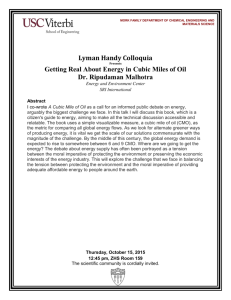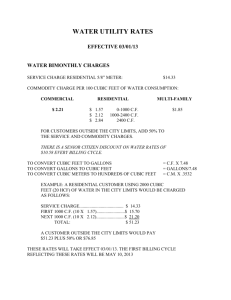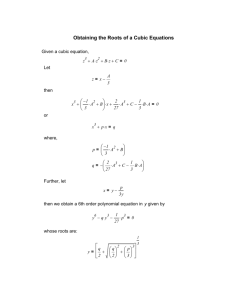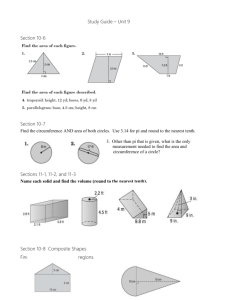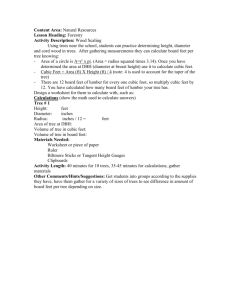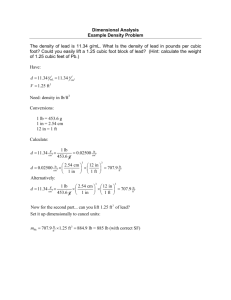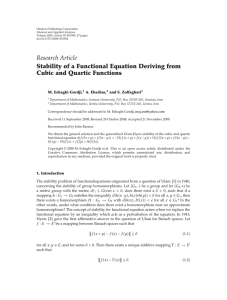MEI Conference 2010 The cubic and quartic formulae
advertisement
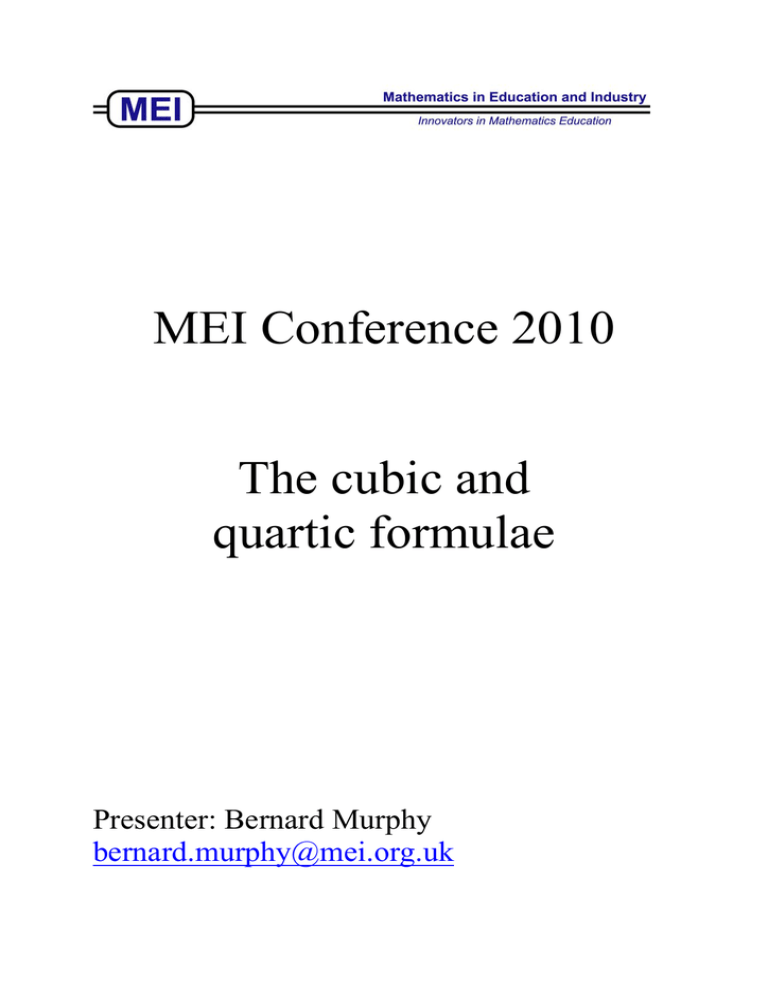
MEI Conference 2010 The cubic and quartic formulae Presenter: Bernard Murphy bernard.murphy@mei.org.uk Scipione del Ferro (1465 – 1526) knew how to solve equations of the form x 3 + mx = n and on his deathbed told Antonio Fior (1506 - ?) who challenged Niccolo “Tartaglia” Fontana (1499-1557) who could already solve equations of the form x 3 + mx 2 = n . He discovered the solution to x 3 + mx = n on February 13th 1535 and so triumphed in the challenge. On March 25th 1539 he told, under oath of secrecy, Gerolamo Cardano (1501 – 1576) who, with his student Ludovico Ferrari (1522 – 1565) read del Ferro’s work in 1543 and published Ars Magna in 1545. Cardano’s method for solving the general cubic. 1. Divide every term of your cubic ax 3 + bx 2 + cx + d = 0 by a, the coefficient of x3 . 2. Use the transformation, x = y − b to give a depressed cubic (i.e. one with no 3a quadratic term): y 3 + my = n 3. Compare the identity ( t − u ) + 3tu ( t − u ) ≡ t 3 − u 3 with your depressed cubic. 3 4. Solve the simultaneous equations 3tu = m and t 3 − u 3 = n to find t and u in terms of m and n. 5. A root of the depressed cubic is y = t − u and so a root of the original cubic is b b x= y− = t −u − 3a 3a 2 3 2 3 n n m n n m y=3 + + −3− + + 2 4 27 2 4 27 Examples 3 2 1. x − 15 x + 81x − 175 = 0 2. x 3 − 15 x = 4 3. x 3 + 9 x = 26 3 2 4. x − 3 x − 3x − 4 = 0 5. x 3 − 6 x = 4 6. x 3 − 6 x = 40 3 2 7. x − 6 x + 11x − 6 = 0 3 2 8. x − 6 x + 13x − 12 = 0 Example. Find the roots of x3 − 15 x 2 + 81x − 175 = 0 First use the substitution x = y + 5 to get a depressed cubic: ( y + 5) 3 − 15 ( y + 5 ) + 81( y + 5 ) − 175 = 0 which simplifies to y 3 + 6 y = 20 . 2 Using the formula with m = 6, n = 20 : 20 202 63 3 20 202 63 y= + + − − + + which simplifies to 2 4 27 2 4 27 3 y = 3 10 + 108 − 3 −10 + 108 = 3 10 + 6 3 − 3 −10 + 6 3 ( But 1 + 3 ) 3 ( = 10 + 6 3 and −1 + 3 ( ) ( ) ) 3 = −10 + 6 3 . Therefore y = 1 + 3 − −1 + 3 = 2 You can see that y = 2 is indeed a root of y 3 + 6 y = 20 . It follows that x = y + 5 = 2 + 5 = 7 is a root of x3 − 15 x 2 + 81x − 175 = 0 . To find the other two roots we divide this polynomial by ( x − 7 ) : ( x 3 − 15 x 2 + 81x − 175 = ( x − 7 ) ( x 2 − 8 x + 25 ) = ( x − 7 ) ( x − 4 ) + 9 2 ) This shows that the roots of the equation x3 − 15 x 2 + 81x − 175 = 0 are x = 7 and the two imaginary roots of x = 4 ± 3i . ------------------------------------------------You may prefer not to use the formula but go back to basics and compare the depressed 3 cubic y 3 + 6 y = 20 with the identity ( t − u ) + 3tu ( t − u ) ≡ t 3 − u 3 . Then 3tu = 6 and t 3 − u 3 = 20 . Substituting u = t3 : (t ) 3 2 2 in t 3 − u 3 = 20 leads to the quadratic in t − 20 ( t 3 ) − 8 = 0 which, on completing the square, gives ( t 3 − 10 ) = 108 and so 2 t 3 = 10 ± 108 = 10 ± 6 3 . Substituting this in t 3 − u 3 = 20 gives u 3 = −10 ± 6 3 . Therefore t − u = 3 10 + 6 3 − 3 −10 + 6 3 which simplifies to ( ) ( ) t − u = 1 + 3 − −1 + 3 = 2 and this is a root of the equation y 3 + 6 y = 20 . u t u t u t u t u t Ferrari’s method for solving the quartic. 1. Divide all terms of the quartic by the coefficient of x 4 to give x 4 + ax3 + bx 2 + cx + d = 0 2. Compare the coefficients of this quartic with those of the quartic 2 2 ⎛ 2 a ⎞ ⎜ x + x + p ⎟ − ( qx + r ) = 0 2 ⎝ ⎠ 3. By eliminating q and r from the resulting simultaneous equations, form a cubic in p. 4. Use Cardano’s method (or other) to find p and then, by substitution, q and r. 5. Consider the two quadratics x 2 + a x + p = ± ( qx + r ) 2 Example Find the roots of x 4 − 4 x 3 − 36 x 2 + 16 x + 128 = 0 Compare the quartic with ( x 2 − 2 x + p ) − ( qx + r ) = 0 : 2 2 Coefficients of x 2 : 2 p + 4 − q 2 = −36 ⇒ q 2 = 2 p + 40 Coefficients of x : − 4 p − 2qr = 16 ⇒ qr = −2 p − 8 Constant term: p 2 − r 2 = 128 ⇒ r 2 = p 2 − 128 (1) ( 2) ( 3) We now can now express q 2 r 2 in two ways: ( −2 p − 8) = ( 2 p + 40 ) ( p 2 − 128) which 2 simplifies to p 3 + 18 p 2 − 144 p − 2592 = 0 . Cardano’s method could be used to find p but there’s no need as the cubic factorises: ( p + 18)( p − 12 )( p + 12 ) = 0 Using p = 12 (see * below) in (1) , ( 2 ) and ( 3) gives q = ±8, r = ±4 and qr = −32 , the latter showing that q and r must have opposite signs. Substituting these back into ( x 2 − 2 x + p ) − ( qx + r ) = 0 gives 2 (x 2 2 − 2 x + 12 ) = ( 8 x − 4 ) and so x 2 − 2 x + 12 = ± ( 8 x − 4 ) . 2 2 This leads to the two quadratics: x 2 − 2 x + 12 = + ( 8 x − 4 ) ⇒ x 2 − 10 x + 16 = 0 ⇒ and x 2 − 2 x + 12 = − ( 8 x − 4 ) ⇒ x 2 + 6 x + 8 = 0 ⇒ ( x − 2 )( x − 8) = 0 ( x + 2 )( x + 4 ) = 0 Therefore the four roots of the quartic are x = 2, −2, −4,8 * Using either p = −12 or p = 18 would give the same four roots in a different order.

